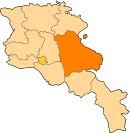Noratus
40°22′48″N 45°10′48″E / 40.38000°N 45.18000°E
Noratus Նորատուս | |
|---|---|
 The Village of Noratus | |
| Coordinates: 40°22′48″N 45°10′48″E / 40.38000°N 45.18000°E | |
| Country | Armenia |
| Province | Gegharkunik |
| Government | |
| • Mayor | Murad Harutyunyan |
| Elevation | 1,925 m (6,316 ft) |
| Population (2010) | |
| • Total | 6,855 |
Noratus (Armenian: Նորատուս; also Romanized as Noraduz) is a major and historical village in the Gegharkunik province of Armenia, near the town of Gavar. It is famous for the Noratus cemetery.
Noratus is first mentioned as a settlement in the Middle Ages, when it was a much larger settlement. The bronze-age megalithic fort near the village points to the notion that Noratus is one of the most ancient continuously inhabited settlements in Armenia.
Northeast of Noratus, there is Gavar transmitter, a huge Soviet-type facility for longwave, mediumwave and shortwave radio broadcasting. There are a great number of medieval monuments and records in the village and around it. One of the famous churches in Noratus is St. Astvacacain church, which is located in the middle of the village. It was built in the late of 9th century by the Gegharkunik prince Sahak. The church was a domed hall, completely built from polished and large stones. It was foundered in the last centuries and as traditionally it is said, the dome and roof were destroyed by the Lezgins. Alashkert immigrants have covered it with timbers. The church had a fenced yard, where now there are many khachkars (Armenian cross-stone) and headstones. The most ancient record is on one of the khachqars, which is now kept in the State Museum of Armenian History.[1]
Gallery
-
Noratus Village as seen from the road to the cemetery
-
Noratus Cemetery
-
Chapel located within the cemetery
See also
References
- ^ Kiesling, Brady (2005). Rediscovering Armenia: Guide (2nd ed.). Yerevan: Matit Graphic Design Studio. pp. 77–78. ISBN 99941-0-121-8.
- Noratus at GEOnet Names Server
- World Gazeteer: Armenia – World-Gazetteer.com
- Report of the results of the 2001 Armenian Census, Statistical Committee of Armenia
- Kiesling, Brady (2005), Rediscovering Armenia: Guide, Yerevan, Armenia: Matit Graphic Design Studio
- Kiesling, Brady (June 2000). Rediscovering Armenia: An Archaeological/Touristic Gazetteer and Map Set for the Historical Monuments of Armenia (PDF). Archived (PDF) from the original on 6 November 2021.





